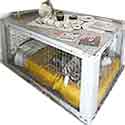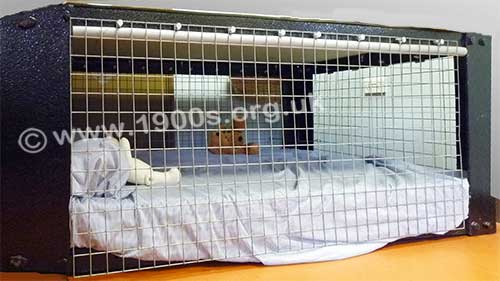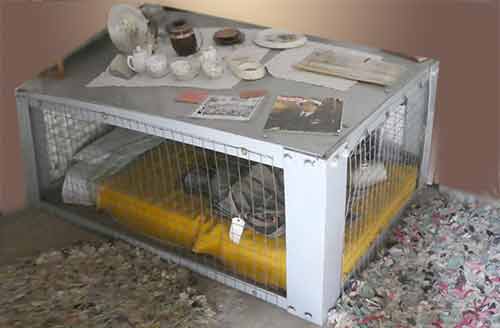The Morrison shelter for protection in WW2 air raids

Morrison shelters were the reinforced, cage-like WW2 bomb shelter of choice for small families wanting to shelter inside their own homes. This page considers their appearance, installation, use as beds and tables and the claustrophobia and excessive heat of using them. A feature is the firsthand, real-life experiences associated with them, not just historical facts.
____
By the webmaster: her early recollections and further research with contributions from others who lived at the time
At the start of the WW2 war the Home Secretary, Herbert Morrison was responsible for air raid precautions. One of his team brought forward a design for a bomb shelter for use inside buildings, which became known as the Morrison air raid shelter or just the Morrison shelter. As the following pictures show, it looked somewhat like a table. Only the single size seem to have survived in museums, but there were double sized ones. My home had a double one.
About half a million Morrison shelters were produced. They arrived as kits with erection instructions for the householder.
For other shelters capable of protecting larger numbers of people see the above menu. The main alternative to the Morrison shelter was the Anderson shelter with space for six or more people. It was the most widely used for larger families, but they had to have gardens large enough to house it.
Advantages and disadvantages of Morrison bomb shelters
Morrison shelters had the appealing advantage that they were for indoors in the warm and dry, and they were the quickest to get to when the air raid warning sounded. However, they took up a lot of space in a room and made the room look untidy, even though they usually doubled as tables in daytime. Air raids mainly took place at night under the cover of darkness.

Morrison bomb shelter - all I ever saw of it as a young child in the blitz of World War Two. I was not tall enough to see over it.*

The view that an adult saw, looking down on the shelter. The top was used as a table.
So people with large families tended to choose an outside Anderson shelter for air raid protection, rather than having to have more than one Morrison shelter indoors.
Morrison shelters were relatively quick to get to when there was an air raid, and they were also warmer than Anderson shelters because they were indoors. Many a time I slept in one.
The location of a Morrison shelter
contributed by Tony Shepherd
These shelters were always downstairs, because the lower floor was stronger than the upper ones. If the house collapsed, the shelter wouldn't fall with it and would be better able to stand the shock.
My parents had a double Morrison shelter in our sitting room, i.e. the front downstairs room of our house. Only much later did I learn that it was called a Morrison shelter, as my mother just called it 'the shelter'.
Appearance of a Morrison shelter
As I was born in 1939, I was too small to see over the top of our Morrison shelter, and to me it was like a four poster bed with no legs, resting on the floor in a cage. I didn't notice anything else about its construction at the time, but it is well-described below in the section on installation.
The tops of the shelters were used as tables, but by the time I was big enough to see over the top of one, the war was over and our downstairs front room had returned to normal.
Tony Shepherd, recollections
Our Morrison shelter gave us a great surface for playing ping pong on.
Inside a Morrison shelter
Our shelter had to sleep me, my mother and my grandmother. My father of course was in the forces, so wasn't there. It was a tight fit, even though it was officially a double version.
The shelter contained a large mattress of sorts, sheets, blankets and pillows - all used for sleeping during the night-time air-raids.
During the latter years of the war, I was still up in the early evenings, and with my young ears, I often heard the wail of a distant siren before my mother did. I always told her because it was fun to go into the shelter. It must have been awful for her, though, tired out at the end of a long day, having to organise her mother and me, and of course losing sleep in the process.
Claustrophobia and excessive heat
contributed by Richard Ouston, recollections
It was cramped and claustrophobic in the Morrison shelter with the four of us lying close together with barely room to turn over. It made body heat a problem too. However families who had the outdoor Anderson shelters were cold and damp. At least we were indoors and dry, even if we were over heated!
Cost of a Morrison shelter
I cannot find any definitive evidence of the cost of a Morrison shelter to a household. Sources on the internet agree on generalities but disagree on details. According to the BBC, families with an anual income under £350 a year were eligible for a free shelter kit, otherwise they were available for purchase for £7-12s. You may like to look at the inflation page to get an idea of how much this was in terms of purchasing power today which is changing all the time.
Installation of a Morrison shelter
contributed by Richard Ouston, recollections
My father set up our Morrison shelter in our dining room. He first erected the steel girder framework and then bolted down a huge sheet of discoloured steel as the 'lid'. The frame was surrounded by wire mesh, held in place with sprung hooks on each corner.
The dash to the shelter when the siren announced an air raid
Whenever the air raid siren sounded, announcing the coming of an air raid, my mother would pick me up from my bed and deposit me in the Morrison shelter.
Then she would try to get her own mother who was living with us. That took time and effort. My mother would be screaming at her to come on and she would announce ponderously, "All right, all right, I'm coming". She was old, widowed and fed up with life, and I realise now that she probably didn't care very much whether a bomb hit us or not.
| sources | webmaster | contact |
Text and images are copyright
If you can add anything to this page or provide a photo, please contact me.



